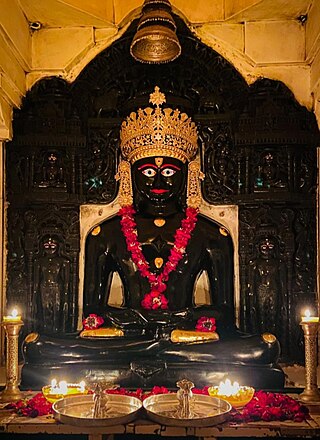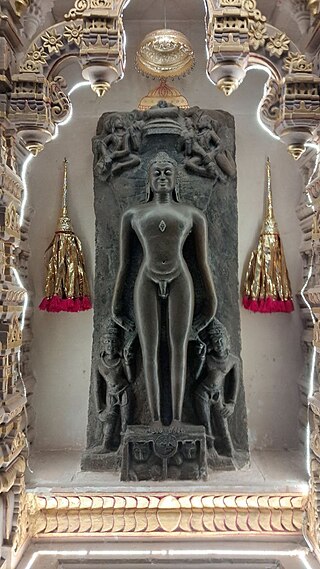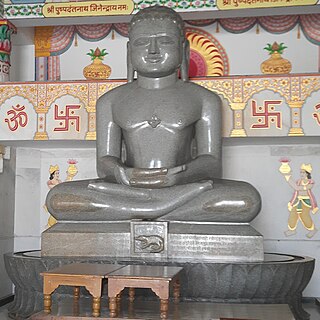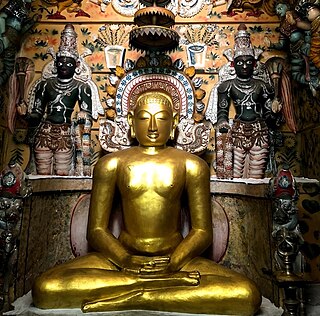
Padampura or Bada Padampura is a Jain temple in Shivdaspura town in Jaipur district of Rajasthan. It is located at a distance of 35 km from Jaipur on Jaipur-Kota road.

Sambhavanatha was the third Jain tirthankara of the present age (Avasarpini). Sambhavanatha was born to King Jitari and Queen Susena at Shravasti. His birth date was the fourteenth day of the Margshrsha shukla month of the Indian calendar. Like all arihant, Sambhavanatha at the end of his life destroyed all associated karmas and attained moksha (liberation).

Sumatinatha was the fifth Jain Tirthankara of the present age (Avasarpini). Sumatinatha was born to a Kshatriya King Megha (Megharatha) and Queen Mangalavati (Sumangalavati) at Ayodhya in the Ikshvaku dynasty. His Janma Kalyanak (birthday) was the eighth day of the Vaisakha Sudi month of the Jain calendar.

Suparshvanatha, also known as Suparśva, was the seventh Jain Tīrthankara of the present age (avasarpini). He was born to King Pratistha and Queen Prithvi at Varanasi on 12 Jestha Shukla in the Ikshvaku clan. He is said to have attained moksha at Shikharji on the sixth day of the dark half of the month of Phālguna.

Shitalanatha was the tenth tirthankara of the present age according to Jainism. According to Jain beliefs, he became a siddha, a liberated soul which has destroyed all of its karma. Jains believe Shitalanatha was born to King Dradhrath and Queen Nanda at Bhaddilpur into the Ikshvaku dynasty. His birth date was the twelfth day of the Magha Krishna month of the Indian national calendar. Shitalanatha is associated with Svastika (Dig.)/ Srivatasa (Svet.) emblem, Pilurikha tree, Brahma Yaksha and Manavi (Dig.) & Ashoka (Svet.) Yakshi.

Shreyansanath was the eleventh Jain Tirthankara of the present age (Avasarpini). According to Jain beliefs, he became a Siddha – a liberated soul which has destroyed all of its karma. Shreyansanatha was born to King Vishnu and Queen Vishna at Simhapuri, near Sarnath in the Ikshvaku dynasty. His birth date was the twelfth day of the Falgun Krishna month of the Indian calendar.

Vasupujya is the twelfth tirthankara in Jainism of the avasarpini. According to Jain beliefs, he became a siddha, a liberated soul which has destroyed all of its karma. Vasupujya was born to King Vasupujya and Queen Jaya Devi at Champapuri in the Ikshvaku dynasty. His birth date was the fourteenth day of the Falgun Krishna month of the Indian calendar. He never married and remained a celibate. He attained Kevala Jnana within one month of Tapsya and Moksha at Champapuri, of Bihar in India on the fourteenth day of the bright half of the month of Ashadh.

Vimalanatha was the thirteenth Jain Tirthankara of the present age (Avasarpini). According to Jain beliefs, he became a Siddha, a liberated soul which has destroyed all of its karma. Vimalanatha was born to King Kratavarma and Queen Shyamadevi at Kampilya of the Ikshvaku dynasty. His birth date was the third day of the Magh Sukla month of the Indian calendar.

Śāntinātha or Śānti is the sixteenth Tīrthaṅkara of Jainism in the present age. According to traditional accounts, he was born to King Vishvasena and Queen Aćira of the Ikshvaku dynasty in the north Indian city of Hastinapur. His birth date is the thirteenth day of the Jyest Krishna month of the Indian calendar. He was also a Chakravarti and a Kamadeva. He ascended to the throne when he was 25 years old. After over 25,000 years on the throne, he became a Jain monk and started his penance.

Munisuvrata or Munisuvratanatha was the twentieth Tirthankara of the present half time cycle (avasarpini) in Jain cosmology. He became a siddha, a liberated soul which has destroyed all of his karma. Events of the Jaina version of Ramayana are placed at the time of Munisuvrata. Munisuvrata lived for over 30,000 years. His chief apostle (gaṇadhara) was sage Malli Svāmi.
Naminatha was the twenty-first tirthankara of the present half time cycle, Avsarpini. He was born to the King Vijaya and Queen Vipra of the Ikshvaku dynasty. King Vijaya was the ruler of Mithila at that time. Naminatha lived for 10,000 years. When Naminatha was in his mother's womb, Mithila was attacked by a group of powerful kings. The aura of Naminatha forced all the kings to surrender to King Vijaya.

Nemināth, also known as Nemi and Ariṣṭanemi, is the twenty-second tirthankara of Jainism in the present age. Neminath lived 81,000 years before the 23rd Tirthankar Parshvanath. According to traditional accounts, he was born to King Samudravijaya and Queen Shivadevi of the Yadu dynasty in the north Indian city of Sauripura. His birth date was the fifth day of Shravan Shukla of the Jain calendar. Krishna, who was the 9th and last Jain Vasudev, was his first cousin.

Ajitanatha was the second tirthankara of the present age, avasarpini according to Jainism. He was born to king Jitashatru and Queen Vijaya at Ayodhya in the Ikshvaku dynasty. He was a liberated soul which has destroyed all of its karma.

Abhinandananatha or Abhinandana Swami was the fourth Tirthankara of the present age (Avasarpini). He is said to have lived for 50 lakh purva. He was born to King Sanvara and Queen Siddhartha at Ayodhya in the Ikshvaku clan. His birth date was the second day of the Magh shukla month of the Indian calendar. According to Jain beliefs, he became a siddha, a liberated soul which has destroyed all of its Karma.

Anantanatha was the fourteenth Tirthankara of the present age (Avasarpini) of Jainism. According to Jain beliefs, he became a siddha, a liberated soul which has destroyed all of its karma.

Chandraprabha or Chandranatha is the eighth Tirthankara of Tīrthaṅkara of Jainism in the present age. According to traditional accounts, he was born to King Mahasena and Queen Lakshmana Devi at Chandrapuri to the Ikshvaku dynasty. According to Jain texts, his birth-date was the twelfth day of the Posh Krishna month of the Indian calendar. He is said to have become a siddha, a liberated soul which has destroyed all of its karma.

Aranath(Arnath) was the eighteenth Jain Tirthankar of the present half cycle of time (Avasarpini). He was also the eighth Chakravartin and thirteenth Kamadeva. According to Jain beliefs, he was born around 16,585,000 BCE. He became a siddha i.e. a liberated soul which has destroyed all of its karmas. Aranath was born to King Sudarshana and Queen Devi (Mitra) at Hastinapur in the Ikshvaku dynasty. His birth date was the tenth day of the Migsar Krishna month of the Indian calendar.

Dharmanatha was the fifteenth Jain Tirthankara of the present age (Avasarpini). According to Jain beliefs, he became a siddha, a liberated soul which has destroyed all of its karma. Dharmanath was born to King Bhanu Raja and Queen Suvrata Rani at Ratnapuri in the Ikshvaku dynasty. His birth date was the third day of the Magh Sukla month of the Indian calendar.

In Jainism, Pushpadanta, also known as Suvidhinatha, was the ninth Tirthankara of the present age (Avasarpini). According to Jain belief, he became a siddha and an arihant, a liberated soul that has destroyed all of its karma.

Kunthunath was the seventeenth Tirthankara, sixth Chakravartin and twelfth Kamadeva of the present half time cycle, Avasarpini. According to Jain beliefs, he became a siddha, liberated soul which has destroyed all of its karma. Kunthunatha was born to King Surya (Sura) and Queen Shridevi at Hastinapur in the Ikshvaku dynasty on the fourteenth day of the Vaishakh Krishna month of the Indian calendar.


























